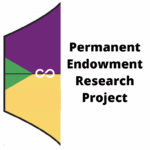 The Permanent Endowment Program creates perpetually multiplying funding for families and/or for 501 (c) 3 non-profit organizations. The objective of the Permanent Endowment Program is to mitigate the endowment deficits of 501 (c) 3 non-profit organizations that provide the caring infrastructure of America. The Permanent Endowment Program was based upon the reality that all human beings are mortal, that human economic value was quantifiable, and that human economic value could be monetized to create perpetually multiplying funding for 501 (c) 3 non-profit organizations.
The Permanent Endowment Program creates perpetually multiplying funding for families and/or for 501 (c) 3 non-profit organizations. The objective of the Permanent Endowment Program is to mitigate the endowment deficits of 501 (c) 3 non-profit organizations that provide the caring infrastructure of America. The Permanent Endowment Program was based upon the reality that all human beings are mortal, that human economic value was quantifiable, and that human economic value could be monetized to create perpetually multiplying funding for 501 (c) 3 non-profit organizations.
The Permanent Endowment Program planning process allocates affluent individuals’ surplus assets to create perpetually multiplying, inter-generational endowment funding for family members and/or for selected 501 (c) 3 non-profit organizations that support value systems that are important to the donor, to the donor’s family, and to society. The Permanent Endowment Program implementation process includes intergenerational, independent third-party administration of the perpetually multiplying funding.
Un-monetized human economic value is a wasted human resource. Findings of the Permanent Endowment Research Project identified the significance of this waste of human economic value to society and developed the Permanent Endowment Program to mitigate this economic loss to society. New Economic Order Planning Program Financial/Endowment Consultants provide a leadership role in the monetization of the human economic value asset through their Permanent Endowment Program implementation efforts.
Non-profit organizations participating in the Permanent Endowment Program work with specially trained Financial/Endowment consultants to obtain a written Permanent Endowment Creation Plan. In addition, 10 Significance Plans are made available for potential Permanent Endowment Program donors. Participating non-profit organizations usually have lists of potential Permanent Endowment Program donors who are capable of making gifts of $1,000,000, or more. These affluent individuals are known to the non-profit organizations because of their past gifts or because of their reputations as donors to non-profit organizations. These affluent individuals and other potential donors can be identified by participating non-profit organizations and mobilized as Permanent Endowment Program donors. Confidential, personalized endowment creation planning is provided in the Significance Plans that are gifted to potential donors by the non-profit organization.
The affluent individuals who receive Significance Plans from the participating non-profit organization enhance their capacity to give from surplus earnings and/or from surplus savings that is identified by their personalized, evidence-based Significance Plans. New Economic Order Planning Program Financial/Endowment Consultants are assigned to participating non-profit organizations to present the Significance Plans to these potential donors and to encourage them to contribute surplus earnings or surplus savings to the participating non-profit organization’s Permanent Endowment Program.
Gifts from Significance Plan donors fund the guaranteed-outcome, human mortality-based financial instruments that create the perpetually multiplying funding of the Permanent Endowment Program. The Permanent Endowment Program is managed by an independent third-party administrator, the Permanent Endowment Foundation, to create the perpetually multiplying, intergenerational funding for the participating non-profit organizations. The perpetually multiplying funds received by the participating non-profit organizations are undesignated funds that can be used at the discretion of the organization to finance their infrastructure costs and their charitable project costs.
The human mortality-based funding instruments provided by participating life insurance companies create perpetually multiplying funding for participating non-profit organizations by monetizing the unused human economic value of individuals in whom the non-profit organization has an insurable interest (employees, directors, trustees, donors, alumni, etc.) An average age of 45 for insureds is desirable.
The life insurance industry objectively defines the amount of life insurance it will underwrite on an individual based upon the individual’s earnings power, accumulated assets, and medical condition. The amount of life insurance made available to an individual from the life insurance industry represents a quantification or monetization of that individual’s human economic value.
Most individuals do not fully monetize their human economic value by purchasing the quantity of “permanent” life insurance that they are eligible to receive. If human economic value is not monetized, a valuable economic asset is wasted. The reasons human economic value is often un-monetized include the fact that many individuals cannot afford the cost, they feel that they do not need that amount of life insurance benefits to meet their family legacy objectives, and/or they do not need that amount of life insurance benefits to meet their charitable endowment objectives.
The second component of the permanent endowment program that creates perpetually multiplying funding for participating non-profit organizations is the full return of premium long-term care insurance program. Special design long term care insurance policies provide full return of premiums benefits that are paid to 501 (c) 3 non-profit organizations that are designated as policy beneficiaries. These refunds of premiums paid for long term care insurance policies create a source of funding for participating non-profit organizations to use to finance their infrastructure costs and their charitable project costs.
Premiums paid by “C” status corporate employers for long-term care insurance policies insuring employees, officers, and/or directors provides tax-free compensation and assisted living benefits to selected officers, directors, and other employees to insure their dignity in old age by preventing involuntary confinement in a nursing home. The premium costs of the long-term care insurance policies are deductible to the “C” status employer and do not create taxable income to the insured employees. Upon the death of the insured individuals, and irrespective of the amount of long-term care benefits received by the insured individuals during their lifetimes, 100% of the premiums paid by the employer to the plan are refunded to the named beneficiary of the policies, the non-profit organizations.